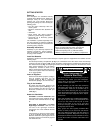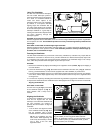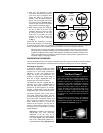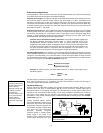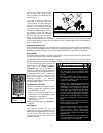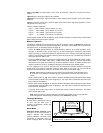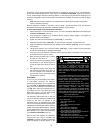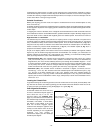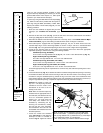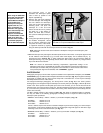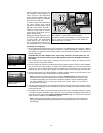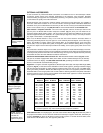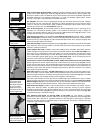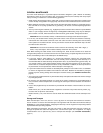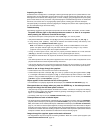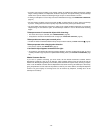
- 17 -
There are two mounting methods available to polar
align the telescope depending on whether you use the
optional #883 Deluxe Field Tripod or a table tripod
(specific to your model of ETX telescope).
To polar align using the #883 Deluxe Field Tripod (Fig.
17), follow the instructions provided with the tripod. To
polar align using the #880 (ETX-90EC) or #881 Table
Tripod (ETX-105EC or ETX–125EC, Fig. 16), use the
following procedure.
1. Make sure the viewfinder is aligned with your ETX
telescope (see
ALIGNING THE VIEWFINDER, page
10).
2. Remove the two hole covers (12, Fig. 1) from the side of the drive base and thread the two identical
fixed legs (4, Fig. 16) into these holes to a firm feel only.
3. Determine the latitude of the observing location from a road map, atlas, or the Latitude Chart for Major
Cities of the World, page 27; determining the latitude within about one degree is sufficient.
4. Each table tripod is equipped with two adjustable tripod legs, only one of which will be used: The
standard tripod leg is used at observing latitudes as shown in step 5 and has a dual latitude label
attached (Fig. 15). The high-latitude tripod leg is shorter and is used at higher observing latitudes.
5. Locate the two mounting holes on the bottom of the telescope drive base. Mount the appropriate
adjustable tripod leg to the drive base using the following latitudes:
Standard Tripod Leg (ETX-90EC)
32.5° to 48.5° uses high-latitude hole (2, Fig. 16). 22° to 35.5° uses alternate hole (3, Fig. 16).
High-Latitude Tripod Leg (ETX-90EC)
56° to 66° uses high-latitude hole. 44° to 55° uses alternate hole.
Standard Tripod Leg (ETX-105EC, ETX-125EC)
33.5° to 49.5° uses high-latitude hole. 23.25° to 36.5° uses alternate hole.
High-Latitude Tripod Leg (ETX-105EC, ETX-125EC)
56.6° to 67° uses high-latitude hole. 44.5° to 56.5° uses alternate hole.
Thread the appropriate leg into the required hole to a firm feel only. Set aside the tripod leg that is not to
be used.
6. A small thumbscrew (6, Fig. 16) is attached to both the standard and high-latitude tripod legs. Loosening
the thumbscrew allows the outer section of the leg to slide over the inner section, so that the leg can be
extended. If using the standard tripod leg, extend the leg so that the center of the thumbscrew head
aligns with the latitude of the observing location on the scale. Retighten the thumbscrew to a firm feel. (If
using the high-latitude tripod leg, complete the adjustment of the leg extension in step 9.)
Example: The latitude of New York
City is 41°. The tripod leg should be
extended so that the center of the
thumbscrew is set next to the 41°
reading on the scale.
Note: With the standard tripod leg
threaded into the appropriate hole in
the drive base, the latitude scale may
be at an inconvenient position for
reading (e.g., the scale faces the
drive base). This situation can be
remedied by unthreading the leg,
removing the thumbscrew, rotating
the inner leg 180°, then reinserting
the thumbscrew. The scale will now
be readable when threaded back into
the telescope base.
7. Loosen the vertical and horizontal
locks (6 and 9, Fig. 1) and rotate the
telescope so that it is oriented as
shown in Fig. 16. Tighten the vertical
Polaris
Little Dipper
Big Dipper
Cassiopeia
Fig. 14: Locating Polaris.
Fig. 15:
Example of
Standard Tripod
Leg Latitude
Scales.
LO
HI
33°
22°
23°
24°
25°
26°
27°
28°
29°
30°
31°
32°
33°
34°
35°
35°
36°
37°
38°
39°
40°
41°
42°
43°
44°
45°
46°
47°
48°
34°
Fig. 16: Example of Polar Alignment Using the #880 Table
Tripod and ETX-90EC. (1) Standard tripod leg with latitude
scale; (2) High-latitude hole; (3) Alternate hole; (4) Fixed tripod
legs; (5) Declination pointer; (6) Thumbscrew;
(7) R.A. scale pointer; (8) #1422 low-latitude balance weight
.
6
2
Dec. at 90°
Polaris
1
5
4
7
3
8



